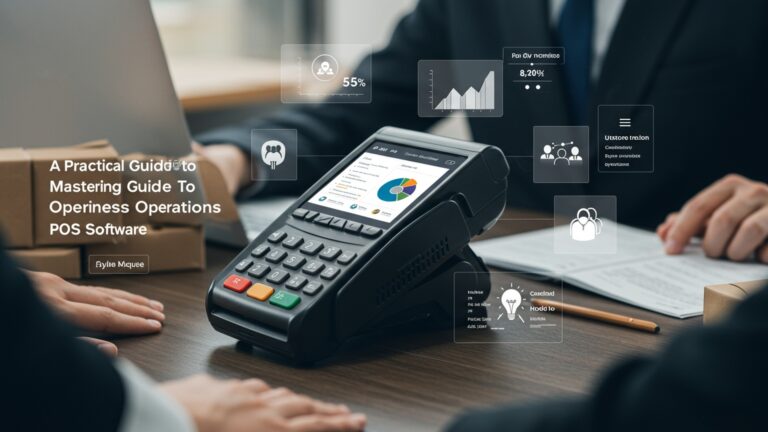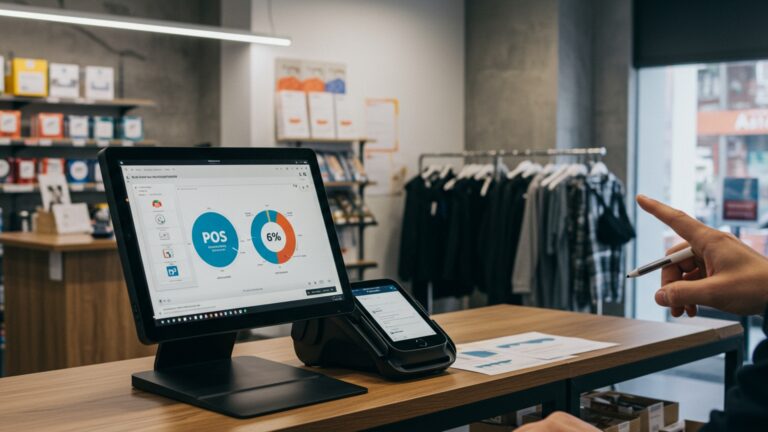Why Cloud Based POS Software is Your Business Future Learn How to Adopt It
In today’s hyper-competitive retail environment, where agility and insight dictate success, relying on antiquated point-of-sale systems is a strategic liability. Traditional setups, often burdened by manual updates and siloed data, simply cannot meet the demands of omnichannel commerce or the need for instantaneous decision-making. This paradigm shift makes cloud based POS software an indispensable tool, transforming transaction processing into a dynamic data hub. Picture a multi-location restaurant chain instantly adjusting menu prices across all branches, or an e-commerce brand seamlessly integrating online sales with in-store inventory for real-time stock visibility. Leveraging its inherent scalability and robust analytics, businesses gain the power to manage operations remotely, enhance customer experiences with personalized offers. optimize supply chains using predictive insights—a clear trajectory towards operational excellence and sustainable growth in the digital age.

Understanding Cloud Based POS Software: A Fundamental Shift in Business Operations
In today’s fast-evolving commercial landscape, the traditional point-of-sale (POS) system, often a static terminal reliant on local servers, is rapidly being superseded by more agile and powerful solutions. At the forefront of this transformation is cloud based POS software. To truly grasp its significance, it’s essential to define what we mean by “POS” and “cloud-based” in this context.
- Point of Sale (POS)
- Cloud-Based
At its core, a POS system is the central hub where all retail transactions are processed. It’s where customers make payments for goods or services. Beyond simple transactions, modern POS systems manage inventory, track sales, generate reports. sometimes handle customer relationship management (CRM) and employee management.
This term refers to software and services that run on the internet instead of locally on your computer or server. Instead of installing and maintaining software on your own hardware, you access it via a web browser or a dedicated app, with data stored and managed on remote servers owned by the software provider. This delivery model is often referred to as Software-as-a-Service (SaaS).
When these two concepts merge, cloud based POS software emerges as a powerful, flexible. scalable solution. Unlike its on-premise predecessors, which required significant upfront investment in hardware and ongoing maintenance by in-house IT teams, cloud POS operates on a subscription model. Your data, from sales records to inventory levels, is securely stored in the cloud, accessible from anywhere with an internet connection. This fundamental shift from local infrastructure to a global, internet-powered platform liberates businesses from the constraints of physical location and offers unprecedented operational agility.
The Unrivaled Benefits for Modern Businesses
The transition to cloud based POS software offers a compelling array of advantages that directly address the challenges faced by contemporary businesses, from small startups to multi-location enterprises.
- Unmatched Accessibility and Mobility
- Significant Cost-Effectiveness
- Seamless Scalability
- Enhanced Data Security and Reliability
- Real-time Analytics and Reporting
- Automatic Updates and Maintenance
- Seamless Integrations
One of the most significant benefits is the ability to access your POS system from any device, anywhere, at any time. Whether you’re managing a pop-up shop, taking orders on the restaurant floor with a tablet, or checking sales reports from home, your entire operation is at your fingertips. This mobility empowers sales associates to serve customers more effectively and owners to maintain oversight even when off-site.
Traditional POS systems often demand substantial upfront capital for hardware, server infrastructure. software licenses. Cloud based POS software typically operates on a subscription model, converting a large capital expenditure into predictable operational expenses. This reduces the initial barrier to entry and eliminates the need for expensive in-house IT staff to manage servers, backups. updates.
As your business grows, your POS needs will evolve. Cloud POS solutions are inherently scalable. Adding new terminals, locations, or features is often as simple as updating your subscription or adding new hardware, without the complex infrastructure overhauls required by on-premise systems. This ensures your POS can grow with you, not hold you back.
While some may initially be concerned about data being “in the cloud,” reputable cloud POS providers invest heavily in robust security measures. They employ advanced encryption, regular backups, redundant servers. compliance with industry standards (e. g. , PCI DSS for payment processing). This often surpasses the security capabilities of a typical small or medium business’s on-premise setup, offering greater peace of mind and protection against data loss or cyber threats.
Imagine knowing your best-selling product, busiest hours, or most loyal customers at any given moment. Cloud based POS software provides real-time data on sales, inventory, employee performance. customer trends. These powerful analytics enable informed decision-making, allowing you to optimize inventory, streamline staffing. personalize marketing efforts, directly impacting your bottom line.
Forget about manual software installations, security patches, or system upgrades. Cloud POS providers handle all maintenance, updates. feature enhancements automatically, often seamlessly in the background. This ensures your system is always running the latest, most secure version with minimal disruption to your business operations.
Modern businesses rely on a suite of tools. Cloud POS systems are designed for integration. They can easily connect with other essential software like accounting platforms (e. g. , QuickBooks, Xero), e-commerce platforms (e. g. , Shopify, WooCommerce), CRM systems, loyalty programs. third-party delivery services. This creates a unified ecosystem that streamlines operations and avoids data silos.
Cloud vs. Traditional POS: A Clear Comparison
Understanding the fundamental differences between cloud-based and traditional on-premise POS systems is crucial for making an informed decision about your business’s future. Here’s a direct comparison:
| Feature/Aspect | Cloud Based POS Software | Traditional (On-Premise) POS |
|---|---|---|
| Deployment | Accessed via web browser/app; data stored on remote servers (SaaS model). | Software installed directly on local computers/servers; data stored locally. |
| Cost Structure | Subscription-based (monthly/annual fees); lower upfront hardware costs. | Large upfront capital investment for software licenses, hardware. servers. |
| Accessibility | Anywhere, anytime, on any internet-connected device. Ideal for multiple locations, mobile sales. | Typically limited to the physical location where the system is installed. Remote access often complex. |
| Maintenance & Updates | Managed automatically by the provider; seamless, often invisible updates. | Requires manual updates, security patches. IT support from your team or a third-party. |
| Scalability | Highly scalable; easy to add new terminals, users, or locations with subscription adjustments. | Scaling often requires significant hardware upgrades and software reconfigurations. |
| Data Security | Managed by provider with robust, enterprise-grade security, encryption. backups. | Depends entirely on your internal IT capabilities and security measures. |
| Integrations | Designed for easy integration with other cloud-based business tools (e. g. , accounting, e-commerce). | Integrations can be complex, costly. may require custom development. |
| Internet Dependency | Requires an internet connection (though many offer offline modes for basic operations). | Functions locally even without internet. lacks remote access and cloud backup. |
Real-World Impact: Case Studies and Applications
The versatility of cloud based POS software means it’s revolutionizing operations across a multitude of industries. Let’s look at some practical applications and a hypothetical case study.
- Retail
- Restaurants and Cafes
- Service Businesses
A boutique clothing store, “Style Haven,” uses cloud POS to manage inventory across its main store and two seasonal pop-up locations. Real-time inventory synchronization prevents overselling. sales data from all locations is consolidated into a single dashboard, allowing the owner to identify trending items and reorder efficiently. Their sales associates can use tablets to process transactions directly on the sales floor, reducing checkout lines and improving customer experience.
“The Daily Grind,” a bustling coffee shop, leverages cloud POS to streamline order taking, integrate with its online ordering platform. manage its kitchen display system (KDS). Baristas take orders on mobile devices, which instantly appear on the KDS, reducing errors and speeding up service. The system also tracks ingredient usage, helping the manager forecast demand and minimize waste.
A beauty salon, “Glamour Hub,” utilizes cloud POS not only for processing payments but also for appointment scheduling, client history tracking. loyalty programs. Clients can book appointments online. stylists can quickly access client preferences and past services, enhancing personalized service.
Case Study: From Clunky to Cloud-Powered
Consider “Artisan Bakes,” a small, family-run bakery that initially relied on a cash register and manual inventory sheets. As their popularity grew, they found themselves constantly battling stockouts, inconsistent pricing. a lack of insight into their most profitable products. Their owner, Maria, spent countless hours reconciling sales and inventory by hand.
After researching various options, Maria adopted a cloud based POS software solution. The transformation was immediate. Sales associates, with minimal training, were processing orders on tablets. Ingredient inventory became automated, triggering alerts when stock levels were low. Maria could now access real-time reports from her smartphone, identifying that her specialty sourdough was their top earner and that Tuesdays were surprisingly slow. This insight allowed her to adjust staffing, introduce a “Two-for-Tuesday” promotion. optimize her baking schedule, leading to a 15% increase in weekly revenue within six months and a significant reduction in food waste. The system’s ability to integrate with her existing accounting software also cut down her weekly bookkeeping from a full day to just a few hours.
Navigating the Adoption of Cloud Based POS Software
Adopting new technology can seem daunting. with a structured approach, transitioning to cloud based POS software can be smooth and highly rewarding. Here’s how to approach it:
- Assess Your Business Needs
- What are your current POS pain points? (e. g. , slow transactions, poor inventory control, lack of reporting).
- What features are essential for your daily operations? (e. g. , multi-location support, online ordering integration, customer loyalty, employee management, kitchen display system).
- What are your future growth plans? (e. g. , expanding to e-commerce, opening new branches).
- Research Cloud POS Providers
- Look for reputable providers with a proven track record. Read reviews, case studies. compare feature sets.
- Consider their pricing models (monthly vs. annual, tiered features).
- Evaluate their customer support options (24/7, phone, email, chat).
- Investigate their security protocols and compliance certifications (e. g. , PCI DSS for payment processing).
- Ask about API availability for custom integrations if needed.
- Plan Your Data Migration
- Identify what data needs to be moved: product lists, customer databases, historical sales data (if desired).
- Work with the new provider to grasp their data import capabilities. Many offer tools or services to help with this.
- Clean up existing data before migration to ensure accuracy in your new system.
- Staff Training
- Even with user-friendly interfaces, proper training is crucial for successful adoption.
- Schedule dedicated training sessions for all staff who will use the system.
- Provide clear, concise guides or quick-reference sheets.
- Designate a “super-user” who can answer basic questions and provide ongoing support.
- Phased Implementation (Optional but Recommended)
- For larger businesses, consider a phased rollout. Start with a single location or department to iron out any kinks before a full launch.
- Run the old and new systems in parallel for a short period if possible, to ensure data consistency and build confidence.
- Actionable Takeaways: Your Adoption Checklist
- ✓ Define your core requirements and “nice-to-have” features.
- ✓ Get demos from at least 3-5 different cloud based POS software providers.
- ✓ Verify security certifications and data backup procedures.
- ✓ Plan your data export and import strategy.
- ✓ Schedule comprehensive staff training.
- ✓ Establish a support contact with your chosen provider.
- ✓ Leverage trial periods to test the system in a real-world scenario.
Overcoming Potential Challenges and Ensuring Success
While the benefits of cloud based POS software are substantial, it’s prudent to address potential challenges and how to mitigate them for a truly successful adoption.
- Internet Dependency
- Mitigation
- Vendor Lock-in and Data Portability
- Mitigation
- Security Concerns
- Mitigation
- Integration Complexity
- Mitigation
- Ongoing Support and Training
- Mitigation
Since cloud POS relies on an internet connection, a stable and reliable internet service is paramount.
Invest in a robust internet connection with a backup option (e. g. , a secondary ISP, a cellular hotspot for emergencies). Many modern cloud POS systems also offer an “offline mode” that allows you to continue processing transactions during an outage, syncing data once connectivity is restored. Always inquire about offline capabilities when evaluating providers.
Changing POS providers in the future can be complex if your data isn’t easily transferable.
Before committing, comprehend the provider’s policies on data export. Can you easily download your sales history, customer data. product lists in a standard format (e. g. , CSV, Excel)? This ensures you retain control over your business data.
Entrusting your sensitive business data to a third party can raise concerns.
Conduct thorough due diligence. Ensure the provider has strong encryption protocols (both in transit and at rest), regular security audits, compliance with industry standards (like PCI DSS for payment processing). robust backup and disaster recovery plans. Look for multi-factor authentication for user access. Reputable providers prioritize security as a core offering.
While integrations are a strength, ensuring they work seamlessly with your existing ecosystem requires attention.
Clearly list all third-party applications you need to integrate (e. g. , accounting software, e-commerce platform). Discuss integration capabilities with prospective POS providers early on. Test these integrations thoroughly during your trial period or initial setup phase.
Technology evolves. new features emerge. Ensuring your team remains proficient is key.
Choose a provider known for excellent customer support and comprehensive training resources (e. g. , knowledge bases, video tutorials, webinars). Establish a clear line of communication with their support team. Schedule periodic refresher training for your staff to ensure they are leveraging all the system’s capabilities.
Conclusion
The shift to cloud-based POS isn’t merely an upgrade; it’s a strategic imperative for businesses navigating today’s dynamic market. Embracing this technology means unlocking unprecedented efficiency, real-time data insights. the flexibility to manage operations from anywhere – crucial for thriving in our increasingly digital landscape. My personal advice? Start small but start now. Don’t let the sheer volume of options paralyze your decision. Focus on your immediate pain points – perhaps inventory management or remote sales – and seek a solution that addresses those first. I’ve witnessed how a local café, by adopting a basic cloud POS, drastically cut stock wastage and improved customer flow during peak hours, leveraging mobile ordering trends effectively. This immediate impact often outweighs the fear of change. By adopting cloud POS, you’re not just buying software; you’re investing in a scalable, resilient future for your business. Take that decisive step today. watch as your operations become more agile, your decisions more informed. your growth trajectory undeniable.
More Articles
Learn How Cloud Based POS Software Boosts Business Efficiency
How to Integrate Billing and POS Software for Maximum Profit
How to Choose the Best POS Software in India for Your Business
Discover How to Optimize Your Business with Smart POS Billing Software
A Comprehensive Guide to Mastering Essential POS Software Features
FAQs
What exactly is cloud-based POS software?
It’s a point-of-sale system that runs online, meaning all your sales data, inventory. customer data are stored securely in the cloud rather than on a local server or computer in your store. You access it through the internet using a browser or an app on various devices.
Why should my business switch to a cloud POS? What’s the big deal?
The big deal is flexibility and efficiency! Cloud POS offers real-time data access from anywhere, automatic software updates, lower upfront costs. better scalability for your business. It helps streamline operations, improve customer service. provides valuable insights to make smarter decisions faster.
How does it help me manage my business better when I’m not even there?
Since it’s cloud-based, you can log in from any internet-connected device – your laptop at home, a tablet on vacation, or your smartphone on the go. You can check sales reports, monitor inventory levels, manage staff. even update product pricing remotely, giving you complete oversight no matter where you are.
Is my sensitive business data safe in the cloud?
Reputable cloud POS providers invest heavily in top-tier security measures like data encryption, regular backups. robust firewalls. They often exceed what a small business could afford for an on-site system, so your data is typically more secure with these experts handling it.
My current system is old. switching sounds like a huge hassle. Is it easy to adopt?
Adopting cloud POS is generally much smoother than you might think. Many providers offer guided setup, data migration tools. comprehensive training to ease the transition. Plus, with no complex hardware to install, you can often get up and running quickly, minimizing disruption to your daily operations.
Will a cloud POS system save my business money in the long run?
Absolutely! You typically pay a predictable monthly subscription instead of a large upfront hardware and software purchase. This eliminates costly server maintenance, manual software updates. significant IT support expenses. Plus, real-time data helps reduce waste and optimize inventory, leading to further savings.
What should I look for when picking a cloud POS for my business?
Consider core features like inventory management, customer relationship management, employee scheduling, reporting capabilities. integration with other tools you use (like accounting software). Also, check for ease of use, mobile accessibility, reliable customer support. transparent, flexible pricing plans.






